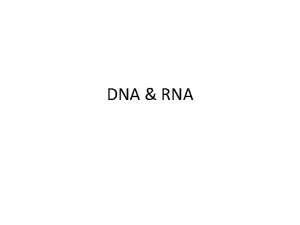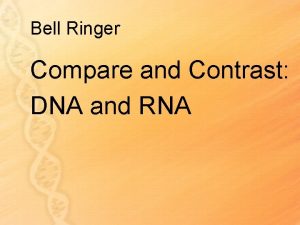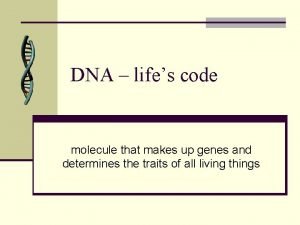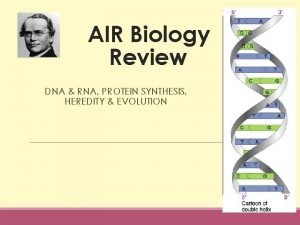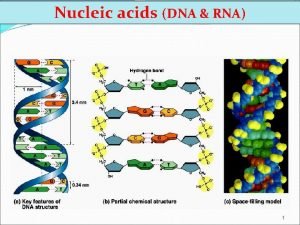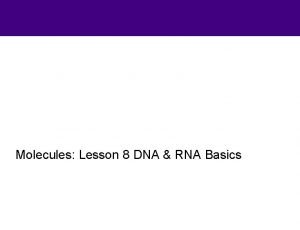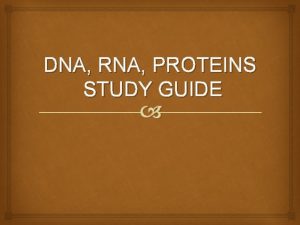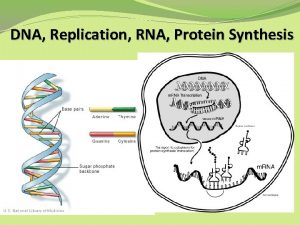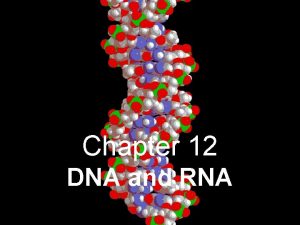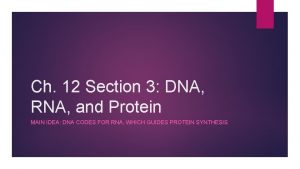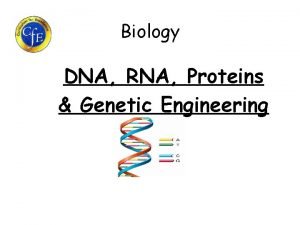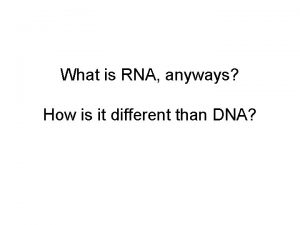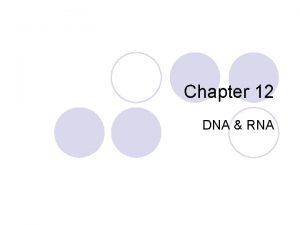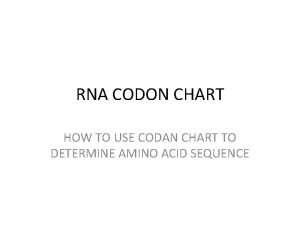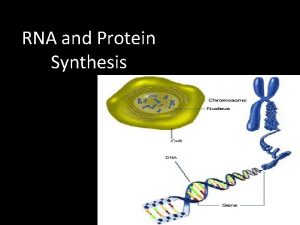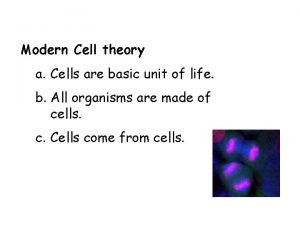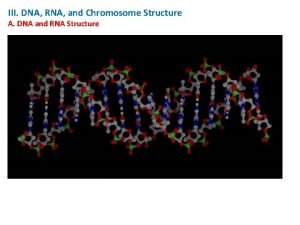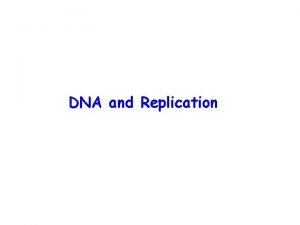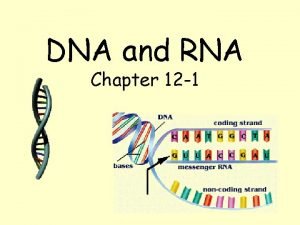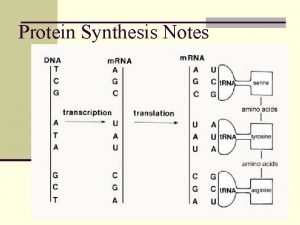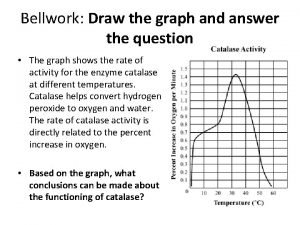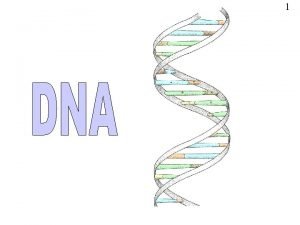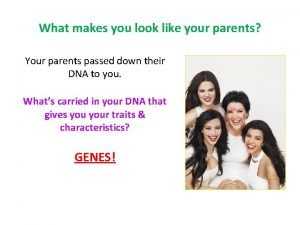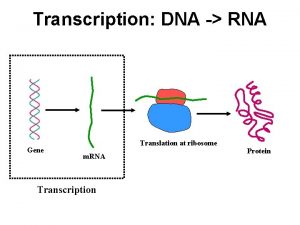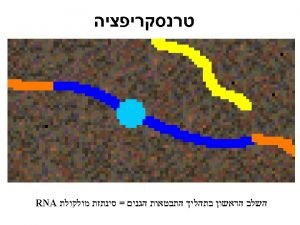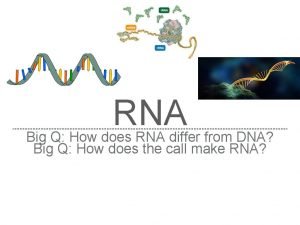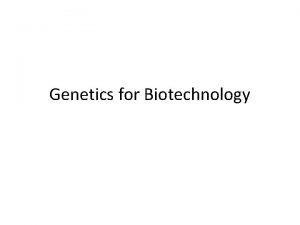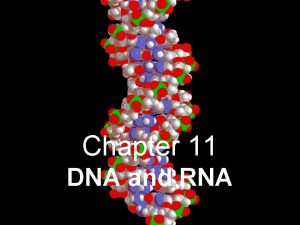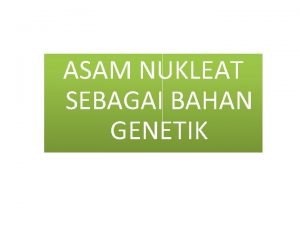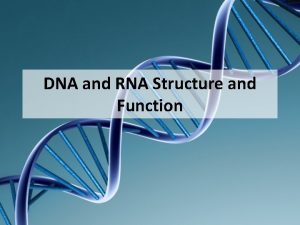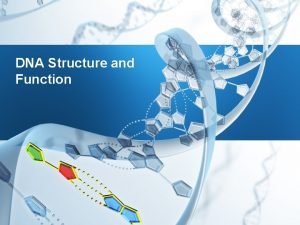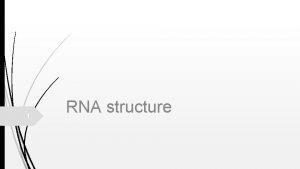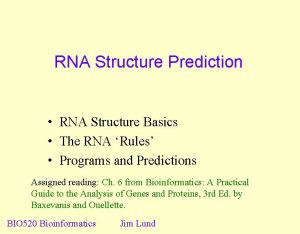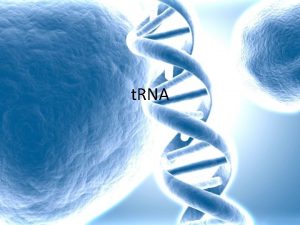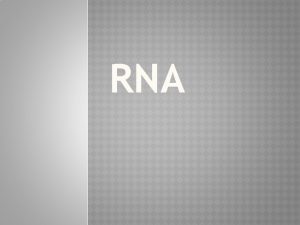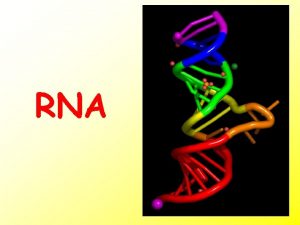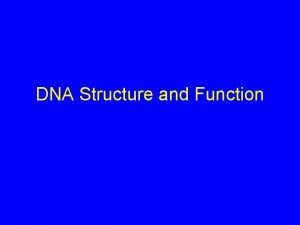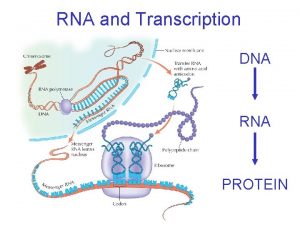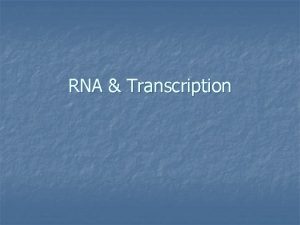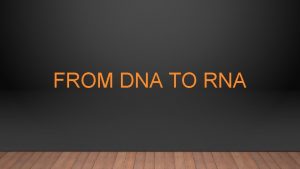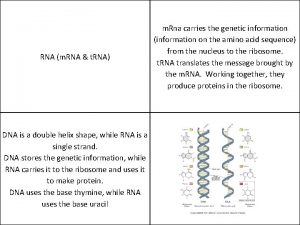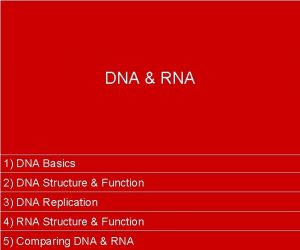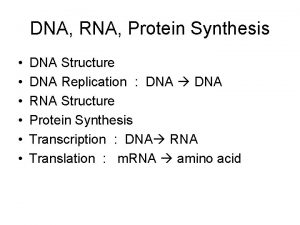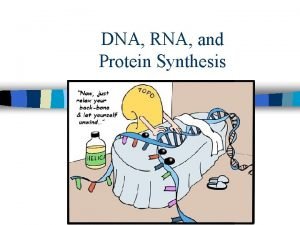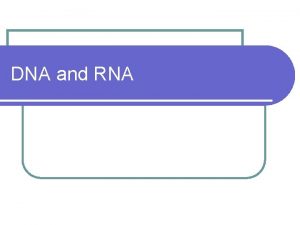DNA RNA THEIR STRUCTURE AND FUNCTION CHEMICAL NATURE





































- Slides: 37

DNA & RNA THEIR STRUCTURE AND FUNCTION

CHEMICAL NATURE OF DNA & RNA �Both the nucleic acids (DNA & RNA) are the macromolecules composed of repeating subunits called nucleotides. Each nucleotide is composed of: �a 5 -carbon sugar �a phosphate group �a nitrogenous base �adenine, thymine, cytosine, guanine, uracil.



Subunits of DNA and RNA Nucleosides linked to phosphate group via ester bond “d. NTP’s”: DNA “r. NTP’s”: RNA

�In polynucleotides such as DNA and RNA, these subunits are joined together in long chains. �RNA exist as single-stranded polymer… �DNA exist as double-stranded molecule…

DNA STRUCTURE THE WATSON & CRICK’S DOUBLE HELIX…

CHEMICAL STRUCTURE OF DNA �One of the most exciting breakthroughs in the history of biology. . . �The year 1953… �James Watson & Francis Crick

MAJOR EVIDENCES �Watson and Crick’s double-helix was based on two major evidences: 1. Chargaff's Rules �Erwin Chargaff and colleagues determined that �amount of adenine = amount of thymine �amount of cytosine = amount of guanine �Hence the total concentration of pyrimidines was always equal to the total concentration of purines.

11. Evidence of Rosalind Franklin Chargaff's realization that A = T and C = G, combined with some crucially important X-ray crystallography work by English researchers Rosalind Franklin and Maurice Wilkins, contributed to Watson and Crick's derivation of the three-dimensional, double-helical model for the structure of DNA.


DOUBLE HELIX

� Although scientists have made some minor changes to the Watson and Crick model, or have elaborated upon it, since its inception in 1953, the model's four major features remain the same yet today. These features are as follows: 1. DNA is a double-stranded helix, with the two strands connected by hydrogen bonds. A bases are always paired with Ts, and Cs are always paired with Gs, which is consistent with and accounts for Chargaff's rule. 2. Most DNA double helices are right-handed; that is, if you were to hold your right hand out, with your thumb pointed up and your fingers curled around your thumb, your thumb would represent the axis of the helix and your fingers would represent the sugar-phosphate backbone. Only one type of DNA, called Z-DNA, is lefthanded.

3. 4. The DNA double helix is anti-parallel, which means that the 5' end of one strand is paired with the 3' end of its complementary strand (and vice versa). As shown in Figure, nucleotides are linked to each other by their phosphate groups, which bind the 3' end of one sugar to the 5' end of the next sugar. Not only are the DNA base pairs connected via hydrogen bonding, but the outer edges of the nitrogen-containing bases are exposed and available for potential hydrogen bonding as well. These hydrogen bonds provide easy access to the DNA for other molecules, including the proteins that play vital roles in the replication and expression of DNA.


PHYSICAL STRUCTURE OF DNA � Three forms of DNA… A-DNA 2) B-DNA 3) Z-DNA 1)

�One of the ways that scientists have elaborated on Watson and Crick's model is through the identification of three different conformations of the DNA double helix. �In other words, the precise geometries and dimensions of the double helix can vary. �The most common conformation in most living cells (which is the one depicted in most diagrams of the double helix, and the one proposed by Watson and Crick) is known as B-DNA. �Intracellular B-DNA appears to have an average of 10. 4 nucleotide pairs per turn.

�There also two other confirmations: A- DNA, a shorter and wider form that has been found in dehydrated samples of DNA and rarely under normal physiological circumstances. It is found in high concentrations of salts or in a partially dehydrated state. It is right-handed with 11 nucleotide pairs per turn. A-DNA is shorter and thicker with 2. 3 nm diameter.

�Z-DNA, a left-handed confirmation. Z-DNA is a transient form of DNA, only occasionally existing in response to certain types of biological activity. Z-DNA was first discovered in 1979, but its existence was largely ignored until recently. Scientists have since discovered that certain proteins bind very strongly to Z-DNA, suggesting that Z-DNA plays an important biological role in protection against viral disease. 12 base pairs per turn and 1. 8 nm diameter.


RNA STRUCTURE


RNA �RNA is the "blueprint" of the Master Plan or the "worker" and it is small enough to leave the nucleus. �RNA is known as ribonucleic acid. �It is a disposable copy of a piece of the DNA strand. �It is made in the nucleus. �It contains the information that DNA gives it to actually physically go out into the cell's cytoplasm and make the actual proteins. �Just like DNA, it is made of repeating units of nucleotides. It has a phosphate, a sugar, and a nitrogen base.

However there are big differences: �RNA contains a different type of sugar than DNA. RNA's sugar is called RIBOSE. �RNA is also not double-stranded like DNA, it is SINGLE-STRANDED (one strand) and also much smaller. �RNA has the same nitrogen bases like DNA, Adenine, Guanine and Cytosine, HOWEVER, instead of Thymine it has Uracil. �Adenine will bond with Uracil. A-U and G-C

TYPES OF RNA There are 3 types of RNA that are made by DNA and take place in making those proteins: �Messenger RNA (m. RNA) �Ribosomal RNA (r. RNA) �Transfer RNA (t. RNA)


Messenger RNA (m. RNA) � “Messenger carrying a message from DNA". �Messenger RNA (m. RNA) is made by DNA, as it's made it makes copies the DNA's instructions to make proteins and then carries these instructions out of the nucleus into the cytoplasm where it finds a ribosome. �They are single stranded templates (like half of a ladder) and they contain CODONS. �Messenger RNA is the ONLY RNA that

�Messenger RNA is made up of 500 to 1000 nucleotides long. Each m. RNA contains codons. �CODONS are groups of 3 bases long. �Codons will code for certain types of amino acids.


Ribosomal RNA (r. RNA) � Just like messenger RNA, ribosomal RNA is made by DNA and just like m. RNA that is single stranded, so is r. RNA. � However, before it leaves the nucleus it folds and coils around itself and forms a glob-like structure. � In the cytoplasm it sits and waits like a docking station where proteins will be made. � In the cytoplasm, ribosomal RNA will bind to the messenger RNA and then it will help assemble (put together) amino acids in the correct order to make proteins. � Therefore you can say that ribosomal RNA is the site of protein synthesis (where proteins are

Transfer RNA (t. RNA) � The 3 rd type of RNA made from DNA is the Transfer RNA (t. RNA). � It also starts out as a single-stranded piece of DNA, but then it bends back on itself forming a hair-pin or cloverleaf type structure. � Only one part is exposed and it contains the ANTICODON. � The messenger RNA contained the codon, and the transfer RNA has the anti-codon. � Anti-codon simply means opposite of the codon. This anti-codon also contains 3 bases and they are the compliment to the codon on the m. RNA. � m. RNA Codon: AUG � t. RNA Anti-Codon: UAC

THE CENTRAL DOGMA �In 1958 Francis Crick suggested an RNA intermediate and proposed that there is a oneway sequential flow of information from DNA to RNA to protein. �This relationship of information transfer between DNA and protein became the Central Dogma theory in molecular biology. �Later the Central Dogma theory was modified when it was found that in special cases RNA can direct the synthesis of DNA; under artificial conditions single-stranded DNA can specify protein.



�Therefore according to central dogma theory a given gene is transcribed to produce a messenger RNA (m. RNA) complementary to one of the DNA strands, and that transfer RNA (t. RNA) molecules translate the sequence of bases in the m. RNA into the appropriate sequence of linked amino acids during protein synthesis.

FUCTION OF DNA & RNA �Storage of genetic information �Self-duplication & inheritance. �Expression of the genetic message. �DNA’s major function is to code for proteins. �Information is encoded in the order of the nitrogenous bases.

�RNA's job is to take the instructions from DNA to actually go out into the cell and make the proteins. �It is the "worker bee". �To make that protein, amino acids must be joined together. �RNA controls how those amino acids that are found in the cytoplasm come together. Amino acids are the building blocks or materials needed to construct that large protein.
 Dna and genes chapter 11
Dna and genes chapter 11 3 componets of dna
3 componets of dna Rna transfer
Rna transfer Similarities and difference of dna and rna
Similarities and difference of dna and rna Dna polymerase function in dna replication
Dna polymerase function in dna replication What is the goal of replication
What is the goal of replication Transcription translation venn diagram
Transcription translation venn diagram Dna double helix coloring worksheet answer key
Dna double helix coloring worksheet answer key Rna types
Rna types Phosphodiester bond
Phosphodiester bond Rnabases
Rnabases Dna rna and proteins study guide answers
Dna rna and proteins study guide answers Fraction
Fraction Dna and rna
Dna and rna Chapter 12 dna and rna
Chapter 12 dna and rna Chapter 12 section 3 dna rna and protein
Chapter 12 section 3 dna rna and protein Dna protein synthesis study guide answers
Dna protein synthesis study guide answers Dna and rna
Dna and rna Diagram of nucleotide
Diagram of nucleotide Section 12-1 dna
Section 12-1 dna Dna mrna trna amino acid chart
Dna mrna trna amino acid chart Dna and rna similarities
Dna and rna similarities Guac wheel
Guac wheel Dehydration synthesis dna
Dehydration synthesis dna Minor groove
Minor groove Chapter 12 dna the genetic material
Chapter 12 dna the genetic material Unlike dna, rna
Unlike dna, rna Amoeba sisters mutations worksheet
Amoeba sisters mutations worksheet Dna to rna rules
Dna to rna rules What is code 1
What is code 1 Dna to protein steps
Dna to protein steps Ribosomem
Ribosomem Rna or dna
Rna or dna Big q
Big q Central dogma
Central dogma Overview of transcription and translation
Overview of transcription and translation Chargaff
Chargaff Protein dalam sel
Protein dalam sel

